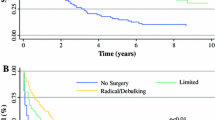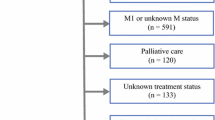Abstract
Background
This study evaluates clinical, radiological and histopathological prognostic indicators for survival of patients undergoing cytoreductive surgery and perioperative intraperitoneal chemotherapy for diffuse malignant peritoneal mesothelioma (DMPM).
Methods
Sixty-two consecutive patients with DMPM underwent cytoreduction and perioperative intraperitoneal chemotherapy at the Washington Cancer Institute. Twenty-six clinical, radiological and histopathological parameters were analyzed in univariate and multivariate analyses using overall survival as an endpoint.
Results
The overall survival was 79 months (range 1–143 months), with 1-, 3- and 5-year survival rates of 84%, 58% and 50%, respectively. The following 14 prognostic variables were significant for survival in the univariate analysis: gender (P = .045), peritoneal cancer index (P = .038), completeness of cytoreduction score (P = .010), interpretive CT findings of the small bowel and mesentery (P = .001), mesothelioma cell type (P < .001), mesothelioma nuclear size (P < .001), nuclear/cytoplasmic ratio (P < .001), mitotic count (P < .001), atypical mitosis (P < .001), chromatin pattern (P < .001), cellular necrosis (P < .001), perineural invasion (P = .037), stroma pattern (P < .001) and depth of invasion (P = .014). In the multivariate analysis, the only factor that was independently associated with an improved survival after cytoreduction and perioperative intraperitoneal chemotherapy was mesothelioma nuclear size.
Conclusions
Mesothelioma nuclear size was the dominant factor determining overall survival in patients with DMPM. A histopathological staging system based on measurement of the nuclear size was proposed.


Similar content being viewed by others
References
McDonald AD, MacDonald JC. Epidemiology of malignant mesothelioma. In: Antman K, Aisner J, eds, Asbestos-related malignancy. Orland FL: Grune & Stratton (1987) pp. 31–5
Asensio JA, Goldblatt P, Thomford NR. Primary malignant peritoneal mesothelioma. A report of seven cases and a review of the literature. Arch Surg 1990; 125:477–81
Sridhar KS, Doria R, Raub WA Jr, Thurer RJ, Saldana M. New strategies are needed in diffuse malignant mesothelioma. Cancer 1992; 70:2969–79
Markman M, Kelsen D. Efficacy of cisplatin-based intraperitoneal chemotherapy as treatment of malignant peritoneal mesothelioma. J Cancer Res Clin Oncol 1992; 118(7):547–50
Neumann V, Muller KM, Fischer M. Peritoneal mesothelioma—incidence and etiology. Pathologe 1999; 20(3):169–76
Eltabbakh GH, Piver MS, Hempling RE, Recio FO, Intengen ME. Clinical picture, response to therapy, and survival of women with diffuse malignant peritoneal mesothelioma. J Surg Oncol 1999; 70(1):6–12
Plaus WJ. Peritoneal mesothelioma. Arch Surg 1988; 123:763–6
Janne PA, Wozniak AJ, Belani CP, et al. Open-label study of pemetrexed a lone or in combination with cisplatin for the treatment of patients with peritoneal mesothelioma: outcomes of an expanded access program. Clin Lung Cancer 2005; 7(1):40–6
Langer CJ, Rosenblum N, Hogan M, et al. Intraperitoneal cisplatin and etoposide in peritoneal mesothelioma: favorable outcome with a multimodality approach. Cancer Chemother Pharmacol 1993; 32:204–8
Sebbag G, Yan H, Shmookler BM, Chang D, Sugarbaker PH. Results of treatment of 33 patients with peritoneal mesothelioma. Br J Surg 2000; 87(11):1587–93
Sugarbaker PH, Acherman YIZ, Gonzalez-Moreno S, et al. Diagnosis and treatment of peritoneal mesothelioma: Washington Cancer Institute experience. Semin Oncol 2002; 29(1):51–61
Park BJ, Alexander HR, Libutti SK, et al. Treatment of primary peritoneal mesothelioma by continuous hyperthermic peritoneal perfusion (CHPP). Ann Surg Oncol 1999; 6(6):582–90
Feldman AL, Libutti SK, Pingpank JF, et al. Analysis of factors associated with outcome in patients with malignant peritoneal mesothelioma undergoing surgical debulking and intraperitoneal chemotherapy. J Clin Oncol 2003; 21(24):4560–7
Sugarbaker PH, Welch LS, Mohamed F, Glehen O. A review of peritoneal mesothelioma at the Washington Cancer Institute. Surg Oncol Clin N Am 2003; 12(3):605–21
Nonaka D, Kusamura S, Baratti D, et al. Diffuse malignant mesothelioma of peritoneum. Cancer 2005; 104(10):2181–8
Jacquet P, Stephens AD, Averbach AM, et al. Analysis of morbidity and mortality in 60 patients with peritoneal carcinomatosis treated by cytoreductive surgery and heated intraoperative intraperitoneal chemotherapy. Cancer 1996; 77:2622–9
Stephens AD, Alderman R, Chang D, et al. Morbidity and mortality of 200 treatments with cytoreductive surgery and hyperthermic intraoperative intraperitoneal chemotherapy using the Coliseum technique. Ann Surg Oncol 1999; 6(8):790–6
Butterworth SA, Panton ONM, Klaassen DJ, Shah AM, McGregor GI. Morbidity and mortality associated with intraperitoneal chemotherapy for pseudomyxoma peritonei. Am J Surg 2002; 183(5):529–32
Glehen O, Osinsky D, Cotte E, et al. Intraperitoneal chemohyperthermia using a closed abdominal procedure and cytoreductive surgery for the treatment of peritoneal carcinomatosis: morbidity and mortality analysis of 216 consecutive procedures. Ann Surg Oncol 2003; 10(8):863–9
Ahmad SA, Kim J, Sussman JJ, Soldano DA, Pennington LJ, James LE, Lowy AE. Reduced morbidity following cytoreductive surgery and intraperitoneal hyperthermic chemoperfusion. Ann Surg Oncol 2004; 11(4):387–92
Swan N, Cottell D, Sheahan K. Peritoneal mesotheliomas. Am J Surg Pathol 1997; 21(1):122–3
Sussman J, Rosai J. Lymph node metastasis as the initial manifestation of malignant mesothelioma. Report of six cases. Am J Surg Pathol 1990; 19:810–28
Reuter K, Raptopoulos V, Reale F, et al. Diagnosis of peritoneal mesothelioma: computed tomography, sonography, and fine-needle aspiration biopsy. Am J Roentgenol 1983; 140(6):1189–94
Guest PJ, Reznek RH, Selleslag D, Geraghty R, Slevin M. Peritoneal mesothelioma: the role of computed tomography in diagnosis and follow up. Clin Radiol 1992; 45(2):79–84
Whitley NO, Brenner DE, Antman KH, Grant D, Aisner J. CT of peritoneal mesothelioma: analysis of eight cases. Am J Roentgenol 1982; 138:531–5
Glehen O, Gilly FN. Quantitative prognostic indicators of peritoneal surface malignancy: carcinomatosis, sarcomatosis, and peritoneal mesothelioma. Surg Oncol Clin N Am 2003; 12:649–71
Sugarbaker PH. Peritonectomy procedures. Ann Surg 1995; 221(1):29–42
Mohamed F, Marchettini P, Stuart OA, Yoo D, Sugarbaker PH. A comparison of hetastarch and peritoneal dialysis solution for intraperitoneal chemotherapy delivery. Eur J Surg Oncol 2003; 29:261–5
Yan TD, Haveric N, Carmignani CP, Chang D, Sugarbaker PH. Abdominal computed tomography scans in the selection of patients with malignant peritoneal mesothelioma for comprehensive treatment with cytoreductive surgery and perioperative intraperitoneal chemotherapy. Cancer 2005; 103:839–49
Cerruto C, Brun E, Chang D, Sugarbaker P. Prognostic significance of histomorphological parameters in diffuse malignant peritoneal mesothelioma. Arch Pathol Lab Med 2006 [accepted for publication]
Riera JR, Astengo-Osuna C, Longmate JA, Battifora H. The immunohistochemical diagnostic panel for epithelial mesothelioma. A reevaluation after heat-induced epitope retrieval. Am J Surg Pathol 1997; 21:1409–19
Ordonez NG. Value of cytokeratin 5/6 immunostaining in distinguishing epithelial mesothelioma of the pleura from lung adenocarcinoma. Am J Surg Pathol 1998; 22:1215–21
Ordonez NG. Role of immunohistochemistry in distinguishing epithelial peritoneal mesothelioma from peritoneal and ovarian serous carcinomas. Am J Surg Pathol 1998; 22:1203–14
Weiss SW. (1994) World Health Organization, International Histological Classification of Tumors. Histological typing of soft tissue tumors, 2nd ed. Berlin: Springer-Verlag.
Goldblum J, Hart WR. Localized and diffuse mesotheliomas of genital tract and peritoneum of women. Am J Surg Pathol 1995; 19:1124–37
Kerrigan SA, Turrnir RT, Clement PB, Young RH, Churg A. Diffuse malignant epithelial mesotheliomas of the peritoneum in women: a clinicopathologic study of 25 patients. Cancer 2002; 94:378–85
Mostofi FK, Davis CJ. (1998) Histological typing of kidney tumors, 2nd ed. New York: Springer.
Hachisuga T, Kawarabayashi T, Iwasaka T, Sugimori H, Kamura T, Tsuneyoshi M. The prognostic value of semiquantitative nuclear grading in endometrial carcinoma. Gynecol Oncol 1997; 65(1):115–20
Acknowledgments
The authors would like to thank Tina Sugarbaker for her maintenance of the peritoneal surface malignancy database. Tristan D. Yan, surgical oncology fellow, is sponsored by the Foundation for Applied Research in Gastrointestinal Oncology and MedStar Research Institute.
Author information
Authors and Affiliations
Corresponding author
Additional information
†Financial disclosure: The authors indicated no potential conflicts of interests.
Rights and permissions
About this article
Cite this article
Yan, T.D., Brun, E.A., Cerruto, C.A. et al. Prognostic Indicators for Patients Undergoing Cytoreductive Surgery and Perioperative Intraperitoneal Chemotherapy for Diffuse Malignant Peritoneal Mesothelioma† . Ann Surg Oncol 14, 41–49 (2007). https://doi.org/10.1245/s10434-006-9169-7
Received:
Revised:
Accepted:
Published:
Issue Date:
DOI: https://doi.org/10.1245/s10434-006-9169-7




